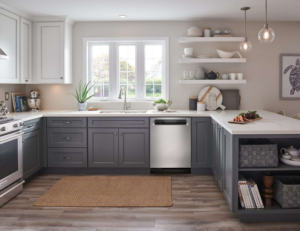For many homeowners, a kitchen remodel is all about making the space work for their lifestyle. Maybe they need more storage or a different layout.
Be sure to keep in mind your budget as you go through the process. It’s easy to overlook small things that add up. You don’t want to be surprised by an unexpected cost at the end of the project. Contact Kitchen Remodel Richmond VA now!

If you’re planning a kitchen remodel, it’s important to think through the design of your new space. A kitchen remodel can be as simple as replacing your appliances, lighting, or cabinetry, or it could involve completely restructuring the room’s layout and adding features like an island or pass-through window. In a bigger remodel, structural changes may be necessary, including adding or removing walls and creating openings for new utilities.
The first step in a major kitchen remodel is demolition, which involves tearing out existing cabinets and fixtures, and ripping up flooring if necessary. It’s often best to leave this work to professionals who are experienced with kitchen remodels. The next step is rough-in, which includes installing and rerouting plumbing, electrical, and HVAC lines. This is another job that’s best left to the experts, but some experienced DIYers can do it themselves.
Once the new utility lines are in place, a drywall contractor can rebuild the walls and install insulation before the drywall goes up. This is also a good time to redo the flooring, whether it’s tile or new composite laminate boards. This is the point where you’ll want to be sure your kitchen design ideas will actually work, so it helps to bring in a professional designer.
When considering your design, be sure to include plenty of storage. Even in small spaces, it’s possible to reclaim space with innovative storage elements like pull-out pan racks, baskets, and trash containers. Also, when choosing cabinetry, look for drawers instead of shelves. These are much more functional than basic shelves, as they allow you to see what’s in each cabinet.
Depending on the scope of your remodel, you’ll probably need to hire a variety of contractors, such as electricians, plumbers, and drywallers. If you’re not comfortable managing the project yourself, consider hiring a general contractor who can coordinate all the work and subcontractors. Other options include finding a contractor who works on commission, or working with a building supplier that offers full design services. These resources can help you keep costs down while still getting the high-quality kitchen you’re dreaming of.
Layout
The layout of your kitchen is an essential step in a remodel. A good layout not only optimizes your space, but it also enhances the overall design of your kitchen. A kitchen remodeling company can help you create a layout that meets your needs and suits the style of your home. They can also help you find the right materials and finishes for your new kitchen.
A kitchen remodel is a big undertaking. It can involve moving appliances, tearing down walls and even relocating pipes. This process can be stressful and overwhelming, but it’s necessary for a functional, beautiful kitchen. A kitchen remodel can add value to your home and make it more functional for you and your family.
Before beginning your kitchen remodel, you must evaluate your needs versus your wants. It’s important to determine what you essentially need in your kitchen, such as sinks, countertops, and cabinets, and what you want, such as an open floor plan or a larger refrigerator. It’s also important to think about resale value and whether you want to add an island or a breakfast bar.
Once you’ve decided what you need and want, you can begin to consider the layout options. A u-shaped or l-shaped kitchen is ideal for most spaces, as they allow for plenty of cabinet and counter space. You can also add a center island for extra seating and additional surface space. Another option is a galley kitchen, which is great for tight spaces and allows you to keep everything within easy reach.
This is a crucial stage in any kitchen remodel, and it requires careful coordination. It’s best to hire a general contractor who can manage the different tradespeople working on your project. They can also provide a timeline for the project and help you stay on budget. This stage can feel chaotic, but it’s actually a carefully coordinated dance of plumbing, electrical, duct, insulation and drywall work.
During this phase, it’s important to have a designated work area. It should be away from the main construction zone and free of dust, debris, and other distractions. It’s also a great time to part ways with items that aren’t serving you anymore.
During kitchen remodeling, the material you choose can make a huge difference in the look and feel of your new space. Some popular choices include granite countertops, hardwood floors and stainless steel cabinets. Each offers different properties, including durability and cost. Educating yourself about each option can help you decide which is right for your home.
Cabinets are another major expense for any kitchen remodel. Budget-friendly options like particleboard and plywood are durable, but they’re not as attractive or functional as solid wood cabinets. For a high-end kitchen, consider custom-built cabinets that offer a wide selection of styles and materials. These cabinets will last longer and can be repainted or resurfaced as needed.
Countertops can also be a style statement, with a range of materials to match any budget. Natural stone products like granite and quartzite are timeless and high-end, but they can have a steep price tag. Other natural stones like slate and poured concrete are more affordable, but they may not be as durable. Laminate, solid surface and ceramic tile are all lower-cost options that are easy to clean and can add a modern look to your kitchen.
If you don’t have the funds for a full kitchen remodel, consider a home equity loan. This type of loan uses your house as collateral, offering a low interest rate and a predictable repayment schedule. However, it is important to understand the risks of taking on such a large debt before making this decision.
Before the remodel begins, create a list of everything you need to keep handy. Items you might not think of include a portable microwave and a toaster oven, as well as an emergency stash of food and water. You’ll also want to clear out the kitchen of any items that could get in the way of contractors and create a bulletin board where you can track progress.
It’s important to stick with your budget during a kitchen renovation. If you can, try to avoid rerunning plumbing and piping, as this can be expensive and disruptive. It’s also a good idea to save any existing appliances you can, as this will keep your costs down.
Budget
A kitchen remodel can be a major investment. To help protect your wallet, experts recommend setting a budget and sticking to it. There are many factors that can influence the final cost of a remodel, including:
The size of your kitchen, which determines how much space you’ll need and how expensive appliances will be. Whether you’re doing a “gut and replace” where everything is replaced or a “partial” remodel that leaves the existing cabinets, counters and appliances in place. How complex the remodel is, including changing the layout of your kitchen and if you’ll need to move electrical, plumbing or gas lines. Materials, such as tile or granite, can have long lead times that can hold up the project.
Cabinets, appliances and labor typically account for the majority of the cost of a kitchen remodel, so make sure you have enough money saved before beginning. Other large costs include demolition, removal and disposal of old materials, and drywall and paint.
Experts also suggest adding 20 percent to your renovation budget for surprises, such as water damage or outdated electric wiring. This is particularly important if your home is older and you’re remodeling an existing kitchen, which is more likely to contain these budget-busting discoveries.
A kitchen remodel is a time-consuming and stressful process, and homeowners can become easily frustrated by unexpected delays or increased expenses. To avoid this, set aside a separate space in your house to escape construction noise, dust and disruptions. Then, stock the space with the essentials, such as plates, bowls and utensils. This way, you won’t need to eat out or resort to microwave dinners every night while the kitchen is torn up.
If you don’t have enough cash on hand to cover a kitchen remodel, you can consider getting a home equity loan or a home equity line of credit (HELOC). Both options require substantial down payments and have variable interest rates, so be sure you understand the terms before you sign on the dotted line. It’s also a good idea to establish a budget spreadsheet and track your spending as the project unfolds. If you start to veer off course, look at the remodel budget you created at the outset and repeat the number like a mantra. This will keep you from splurging on extras that can quickly inflate your renovation costs.

